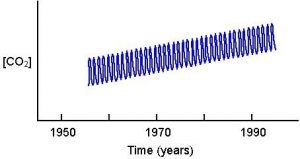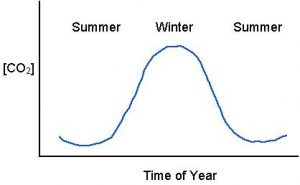Jade Lemm
For the last 400,000 years plants have been adapted to low Carbon dioxide (CO2) of approximately 180ppm (parts per million) up until the Anthropocene era. However low CO2 was not always the case, up until the end of the Phanerozoic era concentrations were suggested to be minimal of 100 times higher current Anthropocene era CO2 (Kasting, 1987). In this current era CO2 has been seen to be rising at an ‘unprecedented rate’ from 1750 of 31% from sources natural and anthropogenic but the dramatic increase can be detected firstly from the industrial revolution (Steffen et al, 2015). These green plants such as forests are part of terrestrial sinks taking up 120 GTC (Giga Tonnes Carbon) per year dependant on location and time of year (Hartmann, Tank & Rusticucci, 2013). The time of year is important as an annual flux in CO2 is indicated by figure 1 showing the change in vegetative seasonality. Plants photosynthesize and draw the CO2 down in the summer but in the winter plants die back causing high CO2 concentrations shown by figure 2 (Gore, 2006).

Fig 1. – The increase of CO2 over time showing the displacement of seasons (Gore, 2006).

Fig 2. – Change in CO2 over the seasons due to plant photosynthesis (Gore, 2006).
It has been debated on a global scale of how terrestrial and marine species would adapt to the rate of CO2 increase as it indicates to be a similar outcome to the Phanerozoic era. For the terrestrial green plant species past data over the 1900’s show that plants were adapted to higher CO2 makes higher plant respiration rates (Wullschleger, Ziska & Bunce, 1994). To adapt to these levels of high CO2 green plants use an enzyme called ‘Rubisco’ but is not an efficient plant as it slows water and nutrients. However, genetic engineering methods are still looking into enhancing this for global future food crisis as 50% demand increase is predicted (Whitney, Houtz & Alonso, 2011). The only way to confirm whether terrestrial plants can adapt to global changing CO2 is to study the effects in controlled environments such as Free Air Carbon dioxide Enrichment (FACE). FACE provides global scale responses from open air natural conditions with releasing controlled CO2 from pipes relying on wind to disperse it. This enables the study of modelling for future CO2, the increase of CO2 under these conditions have provided different effects on different species (McLeod & Long, 1999). For example, seeds of rice provided a yield growth increase of 5-7% under conditions of 550ppm for future conditions, compared to wheat at the same future conditions showed an increase of 27% with a further increase of 3% up to 650pmm (Ainsworth & Long, 2005). But these experiments all depend on the environment that they are placed in as it is all achieved by natural dispersal and planting time, the plants were only successful if early planting was achieved with the correct temperature and moisture. This varied at locations so studies in Australia would have to monitor the crops more carefully compared to Arizona (Mollah, Norton & Huzzey, 2009). However, more research is needed in this still unknown area to quantify the future.
References
Ainsworth, E.A. and Long, S.P., 2005. What have we learned from 15 years of free‐air CO2 enrichment (FACE)? A meta‐analytic review of the responses of photosynthesis, canopy properties and plant production to rising CO2. New Phytologist, 165(2), pp.351-372.
Gore, A., 2006. An inconvenient truth: The planetary emergency of global warming and what we can do about it. Rodale.
Hartmann, D.L., Tank, A.M.G.K. and Rusticucci, M., 2013. IPCC fifth assessment report, climate change 2013: The physical science basis. IPCC AR5, pp.31-39.
Kasting, J.F., 1987. Theoretical constraints on oxygen and carbon dioxide concentrations in the Precambrian atmosphere. Precambrian research, 34(3-4), pp.205-229.
McLeod, A.R. and Long, S.P., 1999. Free-air carbon dioxide enrichment (FACE) in global change research: a review. Advances in ecological research, 28, pp.1-56.
Mollah, M., Norton, R. and Huzzey, J., 2009. Australian grains free-air carbon dioxide enrichment (AGFACE) facility: design and performance. Crop and Pasture Science, 60(8), pp.697-707.
Steffen, W., Broadgate, W., Deutsch, L., Gaffney, O. and Ludwig, C., 2015. The trajectory of the Anthropocene: the great acceleration. The Anthropocene Review, 2(1), pp.81-98.
Whitney, S.M., Houtz, R.L. and Alonso, H., 2011. Advancing our understanding and capacity to engineer nature’s CO2-sequestering enzyme, Rubisco. Plant Physiology, 155(1), pp.27-35.
Wullschleger, S.D., Ziska, L.H. and Bunce, J.A., 1994. Respiratory responses of higher plants to atmospheric CO2 enrichment. Physiologia Plantarum, 90(1), pp.221-229.
Word count: 497
Recent Comments